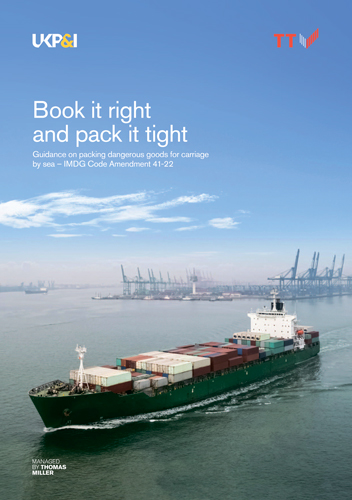Book it right and pack it tight. Guidance on packing dangerous goods for carriage by sea – IMDG Code Amendment 41-22/Забронируйте его правильно и упакуйте плотно. Руководство по упаковке опасных грузов для морской перевозки – Поправка к МКМПОГ 41-22
Книга на английском языке
As I consider the journey that has led to this most recent amendment to the IMDG Code , I think it is worth reflecting on how far we have come as an industry. Modern regulations and guidance, here expanded and improved, that maintain the safety of maritime transport have their roots in international treaties negotiated over one hundred years ago. Then, as now, the disparate nature of maritime transport and its stakeholders required an exceptional level of coordination as governments, shippers, port operators and invested businesses sought to eliminate loss of life and cargo at sea. As the level of international commerce has grown, so too has the need for ever closer coordination between these diverse stakeholders.
This very coordination has always been the greatest challenge facing participants in the global freight supply chain. The temptation is always to view our own organization, our own business, our own role in isolation from the larger network of the supply chain as we seek to meet our own unique goals. Fortunately, we are reminded from time to time of our larger responsibilities towards the partners and counterparties with whom we work, the environment in which we operate, the societies whom we ultimately serve.
The modern supply chain reflects an ever changing tapestry of risk and efforts to combat it Every incident we experience reflects a breakdown in these efforts which results from actions and decisions taken by individual participants. As stakeholders, we must constantly be reminded that such unfortunate outcomes may only be combated through furthering education and communication of the procedures and regulations that protect us all. For this reason, I am pleased to lend my support to this guide presented by UK P&l Club and TT Club, and I would like to encourage its wider distribution to all stakeholders operating in the intermodal supply chain who might draw benefit from it. It is worth remembering that it is often the actions of the shipper who initiates a transport and his appointed container packer that drive the outcomes we seek to avoid.
As we review the changes implemented within Amendment 41 -22 of the IMDG Code, which are presented in this guide, it is a perfect opportunity to be reminded of our larger responsibilities and to consider our place in making the supply chain safe and secure. The messages contained in this guide represent the cumulative work of generations. As we press onward with the unflagging business of moving goods around the globe, we must remember to remain ever vigilant as we seek to maintain the standards presented herein.
Contents
Foreword
Introduction
Step 1: Classification of dangerous goods
Step 2: Selection of packaging
Step 3: Marking and labelling of packages
Step 4: Preparing the transport document for booking with the shipping line
Step 5: IMDG segregation
Step 6: Packing the cargo transport unit
Step 7: The packing certificate
The final objective: Safely loading containers to the ship
Reference and Classification
What are dangerous goods and how are they identified?
Structure of the International Maritime Dangerous Goods (IMDG) code
Classification of dangerous goods for transport
Subsidiary hazards (sub-hazards)
Entries in the Dangerous Goods List: UN Numbers and Proper Shipping Names
Entries in the Dangerous Goods List: UN Numbers and Proper Shipping Names
Packing groups
Articles containing dangerous goods N.O.S
Determination of flashpoints for flammable liquids
Special controls for polymerizing and unstable substances stabilized for transport
Dangerous goods forbidden for transport
Additional certification that may be required from the shipper
Provisions for empty uncleaned tank containers
Provisions for shipping dangerous goods in Limited Quantities
Excepted Quantities
Fumigated cargo transport units
Case study
Case
References
Checklist
Checklists
About us




